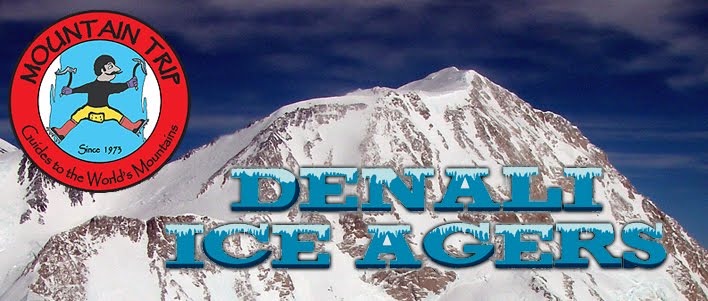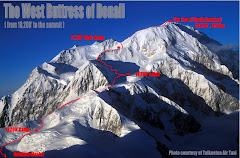
Denali is a massive mountain with a greater rise than Everest. After leaving base camp at 7,200 on the southeast fork of the Kahiltna Glacier, climbers will carry supplies to camp 1. To accomplish this, they will have full backpacks and pull sleds laden with gear to last them three weeks on the mountain. This is the only time they'll make a single carry between camps. Subsequent camp moves will require caching equipment and returning for it later. Add to that any weather delays, and this is what causes Denali expeditions to be so long. Expedition followers will get a better sense of this as expedition reports are dispatched by the Mountain Trip staff and others.
Of course, climbers start following this weather link weeks before their climb begins. Making weather matters inherently worse, is the fact that Denali lies in the higher latitudes where the atmospheric pressure is slightly less than at the Equator. This artificially makes Denali seem like it's almost 23,000' high. This puts even greater pressure on the team to acclimatize as they ascend the mountain.

(Photo by Alasdair Turner)
Although the ratio of oxygen in the atmosphere remains the same at high altitude, the reduced atmospheric pressure means less oxygen. The body adjusts for this reduced oxygen by enabling the red blood cells to absorb more oxygen, which thickens the blood. The heart rate will also rise to compensate for reduced oxygen saturation levels. Denali Ice Agers team member Art Huseonica will be carrying an oximeter with him to measure his pulse and blood oxygen saturation levels throughout the climb.
Art's sea level resting pulse is 52 with an oxygen saturation level of 99 percent. At times during the climb, his pulse will be 152 with an oxygen saturation level of 72 percent; a condition that at sea level, would send a person to the emergency room.

The stay at camp 4 (high camp) will be only long enough to make a summit bid. At 17,200,' the body is in a state of deterioration due to the low oxygen level in the atmosphere. Even a bowel movement takes great effort. All solid wastes are either dropped into a designated deep crevasse or carried in Clean Mountain Cans (see photo above) as mandated by the National Park Service. In addition, all trash is discarded in a designated crevasse or carried off the mountain.
Art Huseonica, team member, Denali Ice Agers Expedition 2010




Art,
ReplyDeleteVery good, detailed article.
Thanks for doing this.
Shlomo